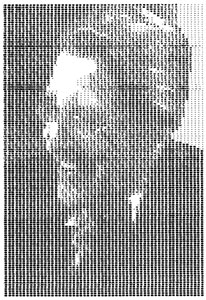Lineprinter graphics

Prof. Dr. Ir. J.P. Schouten (1883-1971), co-founder Mathematisch Centrum [1]
An example of a dataset for lineprinter graphics is the text file tiger.txt [2] which I found on a reel of paper tape. Viewing this file on a computer screen by means of a text editor doesn't produce a convincing result. Therefore I wrote a TurboPascal program tiger4.pas which translates the character data back to gray-valued pixels.
I used the 5*7 dots character set of the Aritma 130 mosaic printer [3] for calculating the gray values corresponding to the various character combinations appearing in the file. The relevant mosaic patterns are in the file patterns. With a few adaptations the program can be used for reconstructing pictures from any text file of this kind.

The version shown here was -after rotation, inversion and cropping- enlarged about three times (with bilinear interpolation), taking into account that square pixels are used in the final picture.
[1] Jaarverslag Stichting Mathematisch Centrum, Amsterdam 1971.
[2] The files tiger.txt, tiger4.pas and patterns are in this zip archive.
[3] This character set is described in A. Ralston (ed), Encyclopedia of Computer Science, Van Nostrand Reinhold 1976.
